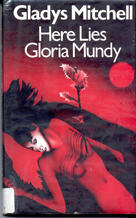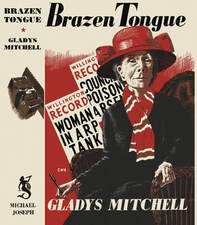Martyn always pays attention to the author's chapter titles, and I am indebted to him for doggedly connecting the dots and sharing his findings with the class. He writes:
"After the allusive expansiveness of earlier chapter headings, these last five have an unexpected brevity, apart from "Iddy Umpty Iddy Umpty Iddy", which I imagined to be GM’s playful rendition of the uninformed attempts at scansion [by a character quoting a poem]. However, it was specifically a card game for teaching the Morse Code Alphabet – a hint that the mystery of Athelstan House is about to be broken?"
Martyn continues, "The first two chapter titles, "Rag" and "Bone", are monosyllabic to the point, though the collocation ‘rag and bone’ must have been in her mind, for the rag and bone man was a familiar figure when GM was writing." Indeed, such a character is integral in Mitchell's classic tale of childhood The Rising of the Moon, published three years after Laurels.
And whilst with time we trifling stand
To practice antique graces,
Age with a pale and withered hand
Draws furrows in our faces.
MASCULINE AND FEMININE
Speaking of ingénue Deborah, Chris and Martyn both tracked the mild-mannered but physically strong Alice Boorman's attraction to the object of conventional feminine beauty. Martyn starts by observing the contrast with Mitchell's depiction of the males from the nearby college, who should be the ladies' natural romantic counterpoints in a genre with straightforward societal mores: "How dull and formulaic are the beefy, rugby-playing male students of Wattsdown with their bulging torsos and fairy costumes compared with the mercurial, playful, ingenuous females of Cartaret. No wonder Alice had a crush on Deborah."
Chris goes further, and his analysis is very much aligned with my interpretation of the author's views and interests of female relationships as Mitchell presents them in her writing. He begins by noting that Laurels' "central action, comprising the bonding of the girl-gang and its adoption of Deborah, I would describe as a blend of semi-adult schoolgirl adventure with screwball comedy – the latter being the favoured form of romantic comedy on stage and screen in the 1935 to 1945 period. In both genres, the emotional substance of same-sex friendship and of heterosexual romance is coolly downplayed or screened by competitively witty dialogue."
More on the author's penchant for offstage resolutions in the paragraphs to come. It is worth noting that, while male queer-oriented characters in Gladys Mitchell's work are almost non-existent, women who do not conform to society's "weaker-sex", feminine expectations abound. After Laurels Are Poison, the series is anchored on the relationship between a formidable, successful professional and her capable, athletic, and independent secretary in the form of Laura.

Joyka notes the author's penchant for letting her guilty characters stop short of being executed, at least by the courts. This may in part be due to the author's personal views of capital punishment, and (to my mind) also may be connected with Mitchell sharing her detective's view that there are degrees of guilt and culpability, especially when motive and situation are assessed. Joyka writes: "I have noticed in all of the Mrs. Bradley books that the perpetrators rarely go to trial, prison, or get the death penalty. Even though her son, Ferdinand, is a brilliant trial lawyer, we rarely see him in action, with the exception of [a highly memorable] murder trial in Speedy Death. I am trying to remember if there is another actual trial with sentencing in any of her books." There may be, but it would be the exception to the rule. It would also surely be treated the way Rex Stout handled the trials of murderers in his Nero Wolfe books: as a coda, meriting little more than a mention.
Joyka notes that the guilty party in Laurels "is allowed to take the easy way out [through suicide] rather than paying society for the murder [of two people]. The vicious pranks are forgotten. One should feel sorry for the police when Mrs. B gets involved. The bad guy or girl is sure to be identified and buried almost at the same time."
Which leads us to GM's handling of her mystery plotlines, both in her work in general and in Laurels in particular. Chris writes that here "the usual satisfactions of a murder-mystery are withheld by keeping the detective process largely offstage, and the murderer completely offstage until the final twist. Puzzle-purists have grounds for complaining that fair-play conventions have not been upheld. That said, this oddly unsatisfactory design is, within its limits, cleverly constructed in that Laura’s central viewpoint is used to misdirect our suspicions towards her prime suspect while Mrs Bradley pursues the true solution elsewhere."
Personally, I admired - and was frustrated with - the narrative structure for exactly these reasons. In these last chapters leading to the ostensible climax, the reader is given a limited view into Laura's thoughts, and the other actors, like Jonathan and the not-overcurious Miss Crossley – chosen by Mrs Bradley because she is a "good stupid horse that will eat [her] oats"! – have limited knowledge of the detective's surmises. In this way, Mitchell is able to deliver a pleasantly surprising perception shift when we realize that the scenario is not what we (or the players) imagined.
But that shift is not brought about by fair play clueing but instead by some late-chapter information that puts a key relationship in the correct perspective. More frustrating to me and the reading group was the choice that most of the important scenes involving the murder story are indeed "offstage" (or alluded to rather than shown). As the Mrs Bradley books over the decades continue, this becomes the norm, as we follow a benign pair of reader proxies who have some physical proximity to the mystery – they discover a body on the moors or are teachers at a school where an instructor goes missing – but they do not actively engage in the drama itself. (They are never really suspects or stakeholders, for example.) Instead, they are perpetual commenters, and Mrs Bradley may visit and talk with them, but likely victim (already dead), suspects, and killer will all remain on the periphery.
Prefacing her earlier note about the strain of insanity in GM's work, Joyka writes, "I find the endings of her books to be the weakest part of her writing." It is another point of dissatisfaction for classic mystery fans: the reveal of the who, why, and how should be the most triumphant part of the journey, the moment they have been waiting for. Tracy observes that Mitchell "uses a different approach from other mystery authors of the same period. Thus, if the reader's main intent is to read a coherent plot that leads logically to the answer, the reader will not get what they want. You have to be open to a circuitous course and (in some cases?) a resolution that may be questionable." I find that a very fair summary, and I understand when a reader's patience is tried along the way.
Even with this criticism, our readers still found many elements and moments to celebrate; this is, after all, a Gladys Mitchell novel. From Martyn: "The initial crime, and the people it involved, is a grim and tawdry affair. It is a miracle that GM managed to concoct such a high-spirited confection with such memorable denizens within it." The characters in Laurels, Deborah's vanity aside, are enjoyable and affecting. Joyka's summary is that "Gladys Mitchell’s Mrs Bradley books keep me interested even when I am rereading. I enjoy the characters, the settings, the descriptions of the countryside and, most of all, the dialogue and dialect."
Tracy also singled out the women student characters in Laurels, and enjoyed Kitty Trevelyan most of all. (She stood out for me on this reading also.) And Chris saw the utility of providing younger, vibrant characters to attract a wider reading audience. He writes that, with that goal, "the lively portrayal of the 'Musketeers' group is successful, of course at the price of sidelining Mrs Bradley and the crimes she investigates."
Writes Tracy: "One major reason I enjoy vintage mysteries is the time that they are set in, and how the life of that time is described. In this case I was surprised that the book was published in 1942 and there was no mention of the war going on. There are plenty of mysteries by other authors of this time that ignore the war. Was this because they wanted to provide entertainment over reality, or because it was impossible to know the outcome at the time?"

Certainly the omission of world events here was a conscious choice for Gladys Mitchell, but she was not one to ignore her circumstances, and in fact used the war and its high global stakes in three intriguing works from that period: Printer's Error (1939), Brazen Tongue (1940), and, most strikingly, in Sunset over Soho (1943), set during the London Blitz. Indeed, GM managed to write and publish eleven titles (!) between 1939 and 1945, in addition to teaching, so one could hardly fault her for being hesitant or idle.
Cheers and happy reading – Jason
 RSS Feed
RSS Feed